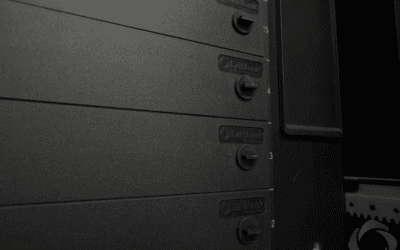In today’s rapidly advancing world, data centers are the backbone of countless operations, powering everything from small businesses to global enterprises. As we push the limits of data consumption, elevate data center performance, and power management, optimizing performance has never been more crucial. With a significant portion of a data center’s energy devoted to cooling systems, innovative solutions like blanking panels are key to enhancing efficiency. Blanking panels, especially variations like server cabinet blanking panels and eziblank blanking panels, serve not just as a tool for managing server racks but as a cornerstone in the quest for data center efficiency.
This article will pivot on how blanking panels, particularly server blanking panels and blanking panels for data centers, can revolutionize airflow management and temperature control. We’ll dive into the types of blanking panels available, including the noteworthy eziblank blanking panels, and discuss their role in optimizing data center cooling. Each segment aims to highlight the blanking panel benefits and guide you in choosing the right blanking panel for your data center, ensuring it runs at peak performance. Stay tuned, as we’ll also tease some of the innovative products available on our site that exemplify these practices.
What are Blanking Panels?
Blanking panels, often referred to as airflow management panels or filler panels, are crucial components in maintaining the efficiency of data centers. These panels are typically made from plastic and are designed to fit seamlessly into the empty slots of server racks. Their primary function is to separate cold air intake areas from hot air exhaust zones, which is vital for effective cooling within the data center.
Overview of Blanking Panel Materials
Metal Blanking Panels
- Durability and Security: Metal blanking panels are known for their sturdiness and tamper-resistant qualities, making them suitable for permanent or semi-permanent installations in data centers.
- Cost and Weight: These panels are generally more expensive and heavier compared to their plastic counterparts, reflecting their enhanced durability and security features.
Plastic Blanking Panels
- Lightweight and Cost-effective: Plastic panels are favored for their affordability and ease of installation, making them a practical choice for temporary or less critical applications.
- Durability Concerns: While they offer economic benefits, plastic blanking panels are still durable like metal options, not limiting their use in environments requiring robust solutions.
Configurations and Sizes
- Standard Sizes: Blanking panels typically come in a range of sizes to cover different numbers of shelving units, commonly referred to by units (1U, 2U, 4U, etc.).
- Custom Features: Some panels include brush strips like our 1RU Brush Panel for enhanced cable management, aiding in maintaining organized and efficient data center operations.
Selection Considerations
When selecting the appropriate blanking panel for a data center, several factors should be considered:
- Data Center Rack Layout: The physical configuration and size of the server racks.
- Budget Constraints: Financial resources available for data center maintenance and upgrades.
- Durability Requirements: Depending on the expected longevity and environmental conditions of the server environment.
- Aesthetic Preferences: The visual design of the data center might influence the choice between panels.
Common Misconceptions
- Usage: A common misconception is that blanking panels are only necessary for covering large gaps in server racks. However, they are crucial for managing airflow efficiently across all unused spaces.
- Airflow Efficiency: It is mistakenly believed that leaving alternate rack shelves empty can promote better cooling. In reality, proper placement of blanking panels enhances overall airflow and cooling efficiency.
By understanding the technical aspects and standard uses of blanking panels, data center managers can significantly improve the operational efficiency and aesthetic appeal of their facilities. These panels play a pivotal role in optimizing the environmental conditions necessary for the reliable and efficient operation of critical data infrastructure.
Optimizing Data Center Cooling with Blanking Panels
Importance of Proper Installation
- Complete Coverage: Ensure that all empty spaces in server racks are covered with blanking panels. This prevents hot air from the exhausts of active equipment from recirculating to the front and mixing with the cold air intended for cooling.
- Seal Gaps Effectively: Utilize grommets like the KOLDLOK Raised Floor Grommets along with blanking panels to seal any gaps around and between the panels. This minimizes air leaks which can significantly impact the efficiency of the cooling system.
Cooling Efficiency and Energy Savings
- Reduced Cooling Requirements: With effective separation of hot and cold aisles by blanking panels, the data center’s cooling systems can operate more efficiently, reducing the overall energy consumption.
- Lower Operational Costs: By improving airflow management, blanking panels help in maintaining lower temperatures within the racks, which reduces the burden on air conditioning systems and lowers energy bills.
Aesthetic and Functional Benefits
- Improved Data Center Appearance: Installing blanking panels gives a neat and organized look to the server racks, enhancing the overall appearance of the data center.
- Dust Reduction: By covering open rack spaces, blanking panels help in reducing the amount of dust that can accumulate on the equipment, thereby lowering maintenance needs and potential thermal issues.
Implementation Best Practices
- Regular Assessment: Regularly check and adjust the placement of blanking panels as the configuration of racks changes with the addition or removal of equipment.
- Comprehensive Installation: Combine blanking panels with other airflow management accessories like air dams or brush strips to further enhance the effectiveness of your cooling strategy.
These steps and considerations highlight the crucial role of blanking panels in optimizing data center cooling. By implementing these practices, data centers can achieve better airflow management, enhanced cooling efficiency, and significant energy savings, all contributing to a more reliable and cost-effective operation.
The Significance of Airflow Management
Essential Role in Data Center Operations
Airflow management is a critical aspect of data center infrastructure, influencing not only the operational costs but also the reliability and efficiency of the equipment housed within. Proper airflow management ensures that cool air reaches all equipment uniformly, preventing hot spots and enabling servers to operate at optimal temperatures.
Key Benefits of Effective Airflow Management
- Enhanced Cooling Efficiency: By using blanking panels and other airflow management tools, data centers can direct cool air precisely where it’s needed, maximizing the effectiveness of cooling systems.
- Reduced Energy Consumption: Efficient airflow management allows for higher set points on cooling systems and reduces the need to overcool, leading to significant energy savings.
- Extended Equipment Lifespan: Proper thermal management through effective airflow prevents overheating, one of the primary causes of hardware malfunction and failure.
Components and Strategies for Improved Airflow
- Aisle Containment Systems: Utilize hot aisle and cold aisle configurations to separate the warm exhaust air from cool intake air, minimizing mixing and enhancing cooling effectiveness.
- Use of Blanking Panels: Install blanking panels to cover unused rack space, preventing the recirculation of hot air back into the cool air stream.
- Strategic Placement of Perforated Tiles: Manage the placement of perforated tiles in raised floor environments to optimize the delivery of cool air and ensure it is not wasted on unoccupied spaces.
Practical Implementations for Airflow Optimization
- Regular Monitoring and Adjustments: Continuously monitor temperature and airflow patterns within the data center and adjust the layout and cooling strategy as needed to address any issues.
- Integration of Cooling Enhancements: Implement in-row cooling units, air diffusers, and rack-mounted cooling solutions to target specific areas that require additional cooling.
- Sealing and Containment: Apply brush grommets and seals around cable cutouts and install physical barriers like curtains or panels to further prevent air mixing.
By prioritizing airflow management, data centers can achieve a balanced environment that supports both the operational demands and the energy efficiency goals critical to long-term sustainability and cost-effectiveness.
Benefits of Implementing Blanking Panels
Enhanced Cooling Performance and Energy Efficiency
- Reduced Cooling Costs: Implementing blanking panels significantly lowers data center cooling costs. By effectively managing airflow and maintaining optimal server room temperatures, these panels reduce the need for excessive cooling efforts, leading to substantial energy savings.
- Prevention of Hot Air Recirculation: Blanking panels play a crucial role in maintaining a clear separation between hot exhaust and cool intake air. This separation minimizes the risk of overheating sensitive components, thus safeguarding equipment from potential damage due to temperature fluctuations.
Improved Data Center Aesthetics and Cleanliness
- Visual Appeal: Proper installation of blanking panels contributes to a more organized and aesthetically pleasing server environment. This not only enhances the professional appearance of the data center but also simplifies maintenance and monitoring activities.
- Dust Reduction: By sealing off unused rack spaces, blanking panels help in minimizing dust accumulation within the racks. Less dust translates to fewer contaminants around critical equipment, reducing the likelihood of thermal issues and maintenance problems.
Protection and Longevity of Equipment
- Barrier Against Contaminants: Blanking panels act as a physical barrier, protecting sensitive data center equipment from dust, debris, and other environmental contaminants. This protection is vital for maintaining the cleanliness and functionality of the equipment.
- Uniform Cooling Across Equipment: By eliminating hotspots and ensuring a consistent distribution of cool air, blanking panels enhance the overall cooling efficiency. This uniform cooling helps in extending the lifespan of the equipment and minimizes downtime due to overheating.
Monitoring and Compliance with Standards
- Enhanced Monitoring Capabilities: Some blanking panels are equipped with integrated temperature monitoring features, such as wireless sensors and temperature strips. These tools allow for real-time temperature tracking, ensuring compliance with industry standards like ASHRAE guidelines.
- Regulatory Compliance and Energy Savings: The strategic use of blanking panels not only aligns with energy efficiency standards but also contributes to significant cost reductions in power consumption, helping data centers meet regulatory requirements and sustainability goals.
Summary of Benefits
| Benefit | Specific Advantages |
|---|---|
| Cooling and Energy Efficiency | Reduces cooling costs, prevents hot air recirculation |
| Aesthetic and Cleanliness | Improves data center appearance, reduces dust accumulation |
| Equipment Protection and Longevity | Acts as a barrier against contaminants, ensures uniform cooling |
| Monitoring and Compliance | Allows for temperature monitoring, ensures compliance with standards |
By integrating blanking panels into data center setups, managers can achieve not only technical and operational improvements but also contribute to a more sustainable and cost-effective data management environment.
Choosing the Right Blanking Panel for Your Data Center
When selecting the appropriate blanking panels for your data center, it’s essential to consider several key factors that will ensure you optimize performance while staying within budget and aesthetic preferences. Here’s a practical guide to help you make the best choice:
Considerations for Selecting Blanking Panels
1. Data Center Rack Layout
- Physical Configuration: Assess the setup of your server racks to determine the size and type of blanking panels needed.
- Space Utilization: Calculate the total unused rack space to estimate the number of panels required.
2. Budget Constraints
- Cost-Effectiveness: Determine your budget for infrastructure improvements and compare the costs between different types of blanking panels.
- Long-Term Savings: Consider the potential energy savings from improved cooling efficiency which might justify a higher initial investment in more durable panels.
3. Durability Requirements
- Material Considerations: Choose between metal and plastic panels based on the expected longevity and environmental conditions in your data center.
- Security Needs: If security and tamper resistance are a concern, metal panels might be more appropriate despite their higher cost and installation requirements.
4. Aesthetic Preferences
- Visual Design: Select panels that complement the overall design and appearance of your data center.
- Consistency: Ensure that the panels match in color and style to maintain a professional look.
Comparison: Plastic vs. Metal Blanking Panels
| Feature | Plastic Blanking Panels | Metal Blanking Panels |
|---|---|---|
| Weight | Lightweight, easy to handle | Heavier, providing robustness |
| Cost | Generally less expensive | More costly due to durability |
| Installation | Tool-free installation, ideal for quick changes | Requires tools for installation and disassembly |
| Aesthetic Flexibility | Available in various styles | Often limited to industrial aesthetics |
Step-by-Step Selection Process
- Evaluate the Rack Space: Measure the unused spaces in your server racks to determine how many and what size panels you will need.
- Assess the Environmental Conditions: Consider the typical environmental conditions such as dust, humidity, and temperature fluctuations in your data center.
- Determine Security and Durability Needs: Based on the criticality of the servers and the physical environment, decide if you need the enhanced security and durability of metal panels.
- Consider Installation and Maintenance: Reflect on the frequency with which you will need to change configurations. Opt for plastic panels if frequent changes are anticipated due to their ease of installation.
- Budget Analysis: Align your choices with the available budget, keeping in mind the potential long-term energy savings from improved cooling efficiency.
By thoroughly evaluating these aspects, you can choose the right blanking panels that not only fit your technical requirements and budget but also enhance the operational efficiency and aesthetic appeal of your data center.
FAQs
1. What are blanking panels and why are they used in data centers?
Blanking panels, also known as filler panels, are crucial for managing airflow within server racks in data centers. They are used to fill empty rack spaces, enhancing airflow efficiency and helping to prevent server overheating by directing the air flow directly towards the servers rather than allowing it to escape through empty spaces.
2. How do blanking panels affect energy consumption in data centers?
Installing blanking panels in empty rack spaces is essential because they prevent the hot exhaust air from equipment from recirculating within the server rack. Without these panels, the recirculated hot air could cause equipment to operate at higher temperatures, prompting cooling systems to work harder. This increased effort results in higher power usage and, consequently, increased energy costs.
3. What is meant by a ‘blank panel’?
A blank panel refers to any panel that is set up but not currently loaded with equipment. These panels are designed with the intention to be outfitted with specific equipment in the future, meaning they are fully prepared and built for specific functions.




